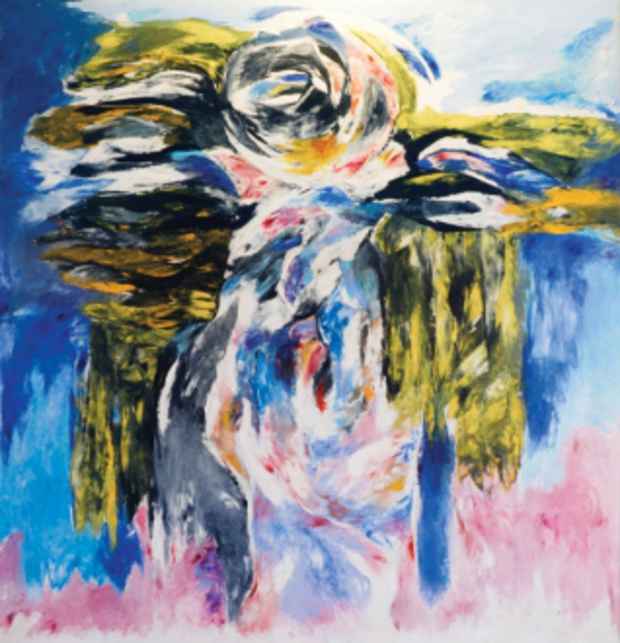"Bella Pacifica" Exhibition
Nyehaus

This event has ended.
In the San Francisco Bay Area, Abstraction found a unique vocabulary. The mid-century avant-garde was composed of a cadre of extraordinarily gifted and energetic artists, each with a distinct personal vision. The Pacific, unlike The Atlantic, is not an ocean BETWEEN continents or worlds, old and new. It is, itself, the center and end of the world. Robinson Jeffers, who spent the better part of his life staring at it, called the Pacific the Eye of the Planet. It’s the void the moon rose from, to which it calls, still.
While they were the inheritors of an Abstraction that came to them as a tradition and a vocabulary of constraint, West Coast painters who were young at mid-century were committed to a modernism that broke rules and moved relentlessly forward. In time, the rules, the nostalgia and the regionalism all came back, but before the wave breaks, it’s all glory.
West coast artists also looked to Zen, to Jazz, and to the sheer overwhelming space and distance of a West that was not yet reduced by highways and jets. Theirs was a Modernism that consumes and abandons its own history; that fights the past and wins. Battlefields come in all shapes and sizes, from the beaches of Normandy to the weave of cotton tacked to a studio wall.
Bay Area Abstraction (also known as “Ecole du Pacifique”, “Hybrid Abstraction,” “free-form” or “first sensation”) flourished under the auspices of Douglas McAgy at the California School of Fine Arts who lead CSFA’s sweeping change in educational philosophy. Most of the artists in this exhibition either studied or taught there in the years from 1945 to 1952.
It is interesting to point out that CSFA’s entire history could be written as a reflection of American military history. The period after WWII was a great social mixer. The waves of GI Bill students created an influx that allowed creative writing and art programs to thrive; artistic communities to be formed; and prepared the rising audience for the avant-garde.
When resigning in 1950, McAgy cites as his main reason the fact that a palpable change was occurring, particularly the loss of a more mature student body. He was referring to the student body he encountered when he started his tenure as director: artists enrolled under the G.I. Bill, such as Jon Schueler, Hassel Smith, Elmer Bischoff, Richard Diebenkorn, and Frank Lobdell. It can be said that as a school, CSFA repudiated geometry, the easel, the frame, the constraint of a border. In one of America’s most beautiful cities, these painters rejected architecture, interior and urban space. The space in which they imagined their work was exterior, natural and vast. Elemental, organic allusions to space as well as specters of the figure remain.
The methods they individually employed–Gestural (Bischoff, Brown); free looping calligraphic lines (Hassel Smith), large canvasses of Color field (Clyfford Still, Jon Schueler, Edward Dugmore), pointilistic (Ernest Briggs and James Kelly), metaphysical (Frank Lobdell and Edward Corbett)—were influenced mainly by landscape; and, in some cases, memories. In the case of Gestural Painting, the influences were the strident sounds of Dixie and Jazz. “...In painting then we were talking about creation, about free creation, about starting from scratch, breaking with the past, destroying the past, destroying the demand of the past, of Europe, of the formal scheme of things, of the convention of painting, and now Abend wanted to do the same thing with music...” (From: The Sound of Sleat: A Painter’s Life by Jon Schueler, Picador USA, 1999, pages 223-225).
Schueler’s recollections evoke a change in Jazz as complete as the change in painting that took place in the 1940’s. Bebop, the music of Charlie Parker, had been kept prisoner in New York by a recording strike for the balance of the war years, and arrived in the rest of the country in 1945 and after, as something full-grown and radically new. Bebop required much more intense, continuous engagement, but at the same time wasn’t social in the same way Jazz had been—it wasn’t dance music any more. This was the same transition painting was making from WPA populism to the highly engaged, but apparently obscure work of the action painters.
Contrary to the absolutist revolutionaries that influenced them (Clyfford Still, Ad Reinhardt and Rothko to name a few) this generation embraced interaction as a way of life. Teachers and students played in a band (CSFA’s “Studio 13” Jazz Band). Twelve of Still’s students (Jon Schueler amongst them) ran the MetArt gallery which operated for a year, opened with an Ernest Briggs show and closed with Clyfford Still. A group of professors—Richard Diebenkorn and Frank Lobdell amongst them, was known as the “Sausalito Six” and met at Lobdell’s studio. Classes—Hassel Smith’s, Clay Spohn’s, Edward Corbett’s, David Park’s—were conducted as talks, energetic discussions, impromptu exercises.
The conflicts and splintering that followed this period of collective effort can once again be traced to the decline of a popular dance music soon to be replaced by rock and roll, and partly about individual versus social art: the end of WPA populism and the rise to market power of the personal gesture.
Was there, then, in fact, an Ecole du Pacifique? Part of our feeling as curators is a gut reaction mingled with curiosity, a belief that there is more than we’ve been lead to believe. That beyond canvases that explode with unresolved problems and angst there is in fact a transcendental beauty, a Pacific Beauty, that has been long overlooked.
Media
Schedule
from January 21, 2011 to March 12, 2011
Preview on 2011-01-20 from 19:00 to 22:00
preview includes dinner, must RSVP to gallery@nyehaus.com